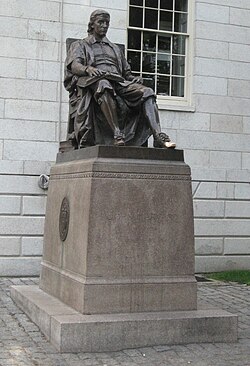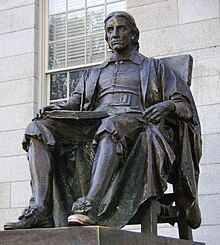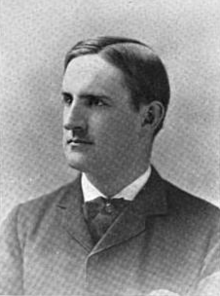| Revision as of 17:00, 13 October 2012 editEEng (talk | contribs)Edit filter helpers, Autopatrolled, Extended confirmed users, New page reviewers, Pending changes reviewers, Template editors98,002 edits statue not "known as" /statue of John Harvard/ -- that's just a syntactic rearrangement of /John Harvard statue/. Neither is it "known as" /statue of the 3 lies/--no one says "meet me at the statue of the 3 lies" -- it's just what tour guides say← Previous edit | Revision as of 17:38, 13 October 2012 edit undoEEng (talk | contribs)Edit filter helpers, Autopatrolled, Extended confirmed users, New page reviewers, Pending changes reviewers, Template editors98,002 edits →Traditions and incidents: again removing material, as explained in earlier edit summaries and (now) on Talk; egage arguments on Talk if you believe it should be restoredNext edit → | ||
| (One intermediate revision by the same user not shown) | |||
| Line 71: | Line 71: | ||
| This leads to the third lie; Harvard was not founded in 1638, as the pedestal of the statue would lead one to believe. | This leads to the third lie; Harvard was not founded in 1638, as the pedestal of the statue would lead one to believe. | ||
| It was actually founded in 1636, but Harvard's bequest was received by the school in 1638.<ref name= "Tuscaloosa"/><ref name="Encyclopedia"/> | It was actually founded in 1636, but Harvard's bequest was received by the school in 1638.<ref name= "Tuscaloosa"/><ref name="Encyclopedia"/> | ||
| ==Traditions and incidents== | |||
| The John Harvard Statue has two main traditions, one for tourists and one for students. | |||
| Tourists, when touring the university and taking pictures with the statue, touch John Harvard's left foot for good luck.<ref name= "Fungi"/> | |||
| Students, on the other hand, have developed a tradition of urinating on the statue late at night.<ref name="Herald">Szaniszlo, Marie. . ]. August 20, 2006. Retrieved October 13, 2012.</ref><ref>Herz-roiphe, Daniel E.. ]. December 18, 2006. Retrieved October 3, 2012.</ref> | |||
| When asked about this tradition by '']'', a senior who lived in the ] dormitory confessed, "Well, I peed on him last weekend."<ref name= "Fungi"/> | |||
| In 2002, Harvard chemistry tutor Stephen J. Haggarty, FM, took swabs of the statue and incubated them. | |||
| He found that despite the statue's use as a pissoir, the bacteria living on it are benign and "are the kinds of species you might find on the metal railings outside University Hall".<ref name= "Fungi"/> | |||
| The John Harvard statue is also a magnet for vandalism. | |||
| According to Harvard's Manager of Administrative Operations the statue is vandalized roughly once a week, even more during football season.<ref name= "Fungi"/> | |||
| == References == | == References == | ||
Revision as of 17:38, 13 October 2012
| This article or section is in a state of significant expansion or restructuring. You are welcome to assist in its construction by editing it as well. If this article or section has not been edited in several days, please remove this template. If you are the editor who added this template and you are actively editing, please be sure to replace this template with {{in use}} during the active editing session. Click on the link for template parameters to use.
This article was last edited by EEng (talk | contribs) 12 years ago. (Update timer) |
| John Harvard statue | |
|---|---|
 | |
| Artist | Daniel Chester French |
| Year | 1884 (1884) |
| Type | bronze |
| Location | Harvard Yard, Cambridge, Massachusetts |
| Owner | Harvard University |
The John Harvard statue is a bronze sculpture representing John Harvard currently located on Harvard Yard at Harvard University in Cambridge, Massachusetts. It was created by Daniel Chester French and presented to Harvard University on October 15, 1884 by General Samuel J. Bridge on the 250th anniversary of the schools founding. As there are no surviving representations of what John Harvard actually looked like, French chose a Harvard student at the time, Sherman Hoar, as a model for the statue. Currently there are two main traditions associated with the statue. Tourists touch John Harvard's left foot for good luck, while students have developed a tradition of urinating on the statue late at night.
Description
The John Harvard statue is made of bronze and sits on a red granite stand. The statue depicts a seated, young clergyman wearing a seventeenth century clerical outfit of, "... low shoes, long, silk hose, loose knee breeches,and a tunic belted at the waist." The John Harvard statue is made of bronze and sits on a red granite stand. The statue depicts a seated, young clergyman wearing a seventeenth century clerical outfit of, "... low shoes, long, silk hose, loose knee breeches,and a tunic belted at the waist." He has an open bible on his lap as well as a stack of books stored under the carved armchair he is sitting in Draped over the chair is a long cloak with deep and dramatic folds. In order to make cleaning of the statue easier, it is currently covered with a layer of paraffin wax.
On one side of the red granite pedestal, in brass, is the seal of Harvard University; on the other is the seal of John Harvard's alma mater, Cambridge University's Emmanuel College.
History

Cast in 1884, the statue was a gift from businessman and longtime Harvard benefactor Samuel J. Bridge in anticipation of the school's 250th anniversary. Daniel Chester French, who had recently gained fame for his statue of a Minute Man at Old North Bridge, Concord, Massachusetts, was chosen as the sculptor, but Charles W. Eliot, then president of Harvard University, had doubts about the whole endeavor. As there was no known portrait or other representation of John Harvard, Eliot was wary of creating something untrue. When talking about his reservations about the proposed statue he stated, "Such a course tends to the confusing and confounding of historic truth, and leaves posterity unable to decide what is authentic and what is mere invention." Despite Eliot’s reservations, French began looking for a model for the sculpture. Harvard president Charles W. Eliot was, at first, concerned that to create a sculptural representation of John Harvard, in the absence of any know depictions of him, "tends to the confusing and confounding of historic truth and leaves posterity unable to decide what is authentic and what is mere invention."
After much searching, French chose a member of the Harvard class of 1882, Sherman Hoar. When explaining why he chose Hoar as his model French wrote that "in looking about for a type of the early comers to our shores, I chose a lineal descendant of them for my model in the general structure of the face.” Hoar was described as the "handsomest contemporary student he could find," but as French said, "Of course I shall not make it a portrait of him."
While the statue was in progress, Eliot made a visit to check on how it was looking. After seeing French’s work, his opinion of the work was changed. “It moves one,” he stated, and he withdrew his objections to the statue. French himself was at times less than sanguine about his work; while working on the statue he wrote, "I am sometimes scared by the importance of this work. It is a subject that one might not have in a lifetime and a failure would be inexcusable. As a general thing, my model looks pretty well to me, but there are dark days."
The statue was completed, and was presented to Harvard University on October 15, 1884. It was installed outside Memorial Hall from its unveiling until 1923, when it was moved to outside University Hall, at least partially due to Daniel Chester French’s desire for it to be there.
Three lies

The statue sits on a pedestal with an inscription of "John Harvard, founder, 1638" carved into it. All three of these inscriptions are untrue. The most glaring of these "three lies" is that the statue is not of John Harvard. The second lie is that John Harvard was the founder of Harvard University as it states under the statue. The University was founded instead by the Massachusetts Bay Colony. The school was founded in 1636 as "New College" or "the college at New Towne" to train Congregational Church ministers. Its name was changed in 1638 to "Cambridge" than again in 1639 to "Harvard" due to John Harvard's roughly $375 bequest following his death. This leads to the third lie; Harvard was not founded in 1638, as the pedestal of the statue would lead one to believe. It was actually founded in 1636, but Harvard's bequest was received by the school in 1638.
References
- ^ The John Harvard Statue. The New York Times. October 16, 1884. Retrieved October 2, 2012.
- ^ The John Harvard Statue. The New York Times. October 18, 1884. Retrieved October 2, 2012.
- Lackman, Abigail C. John Harvard? He's a Fungi. The Harvard Crimson. October 31, 2002. Retrieved October 3, 2012.
- ^ Bethell, John T., Hunt, Richard M., Shenton, Robert. Harvard A to Z. Harvard University Press. p.230. 2004. Retrieved October 12, 2012.
- Ury, Faryl. John Harvard Statue Vandalized. The Harvard Crimson. October 2, 2002. Retrieved October 2, 2012
- ^ Shand-Tucci, Douglas (2001). The Campus Guide: Harvard University. Princeton Architectural Press. p. 47. ISBN 9781568982809.
- Goldberg, Carey. From John Harvard to Ramses II. The New York Times. September 14, 1997. Retrieved October 3, 2012.
- ^ Honan, William H. Applying to college? Try just a few pointers. The Tuscaloosa News. November 25, 1995. Retrieved October 3, 2012.
- ^ John Harvard Facts, Information. The Columbia Encyclopedia, Sixth Edition. 2008. Retrieved October 3, 2012.